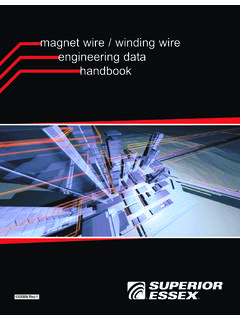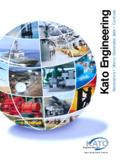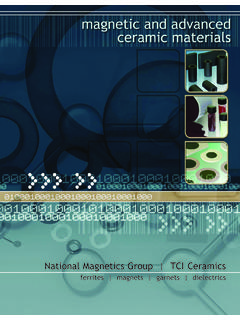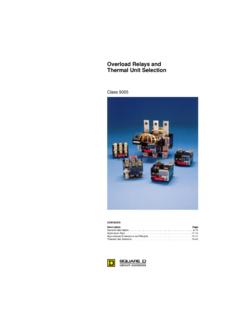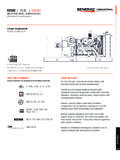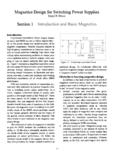Transcription of LEESON Basic Training - Electric Heaters,Level …
1 Basic TRAININGMOTORS, GEARS & DRIVESINDUSTRIAL-DUTY & COMMERCIAL-DUTYE lectric MotorsGear ReducersGearmotorsAC & DC Drives-1- Basic Training Industrial-Duty & Commercial-DutyElectric MotorsGear ReducersGearmotorsAC & DC DrivesA Publication OfCopyright 1999 Price $ ..4 Electric Motor History and PrinciplesII. General Motor Replacement Guidelines ..7 III. Major Motor Types ..10AC Single PhaseAC PolyphaseDirect Current (DC)GearmotorsBrakemotorsMotors For Precise Motor ControlIV. Mechanical Considerations.
2 16 Enclosures and EnvironmentNEMA Frame/Shaft SizesNEMA Frame SuffixesFrame PrefixesMountingV. Electrical Characteristics and Connections ..24 VoltagePhaseCurrent FrequencyHorsepowerSpeedsInsulation ClassService FactorCapacitorsEfficiencyThermal Protection (Overload)Individual Branch Circuit WiringReading a LEESON Model NumberMajor Motor Components-2-VI. Metric (IEC) Designations ..34 VII. Motor Maintenance ..39 Lubrication ProcedureRelubrication Interval ChartVIII. Common Motor Types and Typical Applications.
3 41IX. Gear Reducers and Gearmotors ..46 Right-Angle Worm Gear ReducersParallel-Shaft Gear ReducersGearmotorsInstallation and Application ConsiderationsSpecial Environmental ConsiderationsGear Reducer MaintenanceX. Adjustable Speed Drives ..55DC DrivesAC Drives One Piece Motor/Drive CombinationsAC Drive Application FactorsMotor Considerations With AC DrivesRoutine Maintenance of Electrical DrivesXI. Engineering Data ..65 Temperature Conversion TableMechanical Characteristics TableElectrical Characteristics TableXII.
4 Glossary ..68-3-CHAPTER IElectric Motor History and PrinciplesThe Electric motor in its simplest terms is a converter of electrical energyto useful mechanical energy. The Electric motor has played a leading rolein the high productivity of modern industry, and it is therefore directlyresponsible for the high standard of living being enjoyed throughout theindustrialized beginnings of the Electric motor are shrouded in mystery, but thismuch seems clear: The Basic principles of electromagnetic induction werediscovered in the early 1800 s by Oersted, Gauss and Faraday, and thiscombination of Scandinavian, German and English thought gave us thefundamentals for the Electric motor.
5 In the late 1800 s the actual inventionof the alternating current motor was made by Nikola Tesla, a Serb who hadmigrated to the United States. One measure of Tesla s genius is that he wasgranted more than 900 patents in the electrical field. Before Tesla s time,direct current motors had been produced in small quantities, but it was hisdevelopment of the versatile and rugged alternating current motor thatopened a new age of automation and industrial Electric motor s principle of operation is based on the fact that a cur-rent-carrying conductor, when placed in a magnetic field, will have a forceexerted on the conductor proportional to the current flowing in the con-ductor and to the strength of the magnetic field.
6 In alternating currentmotors, the windings placed in the laminated stator core produce the mag-netic field. The aluminum bars in the laminated rotor core are the current-carrying conductors upon which the force acts. The resultant action is therotary motion of the rotor and shaft, which can then be coupled to variousdevices to be driven and produce the types of motors are produced today. Undoubtedly, the most com-mon are alternating current induction motors. The term induction derives from the transference of power from the stator to the rotor throughelectromagnetic induction.
7 No slip rings or brushes are required since theload currents in the rotor conductors are induced by transformer induction motor is, in effect, a transformer - with the stator windingbeing the primary winding and the rotor bars and end rings being the mov-able secondary single-phase and polyphase AC motors are produced by LEESON and many other manufacturers. In polyphase motors, the place--4-ment of the phase winding groups in conjunction with the phase sequenceof the power supply line produces a rotating field around the rotor rotor tends to follow this rotating field with a rotational speed thatvaries inversely with the number of poles wound into the stator.
8 Single-phase motors do not produce a rotating field at a standstill, so a starterwinding is added to give the effect of a polyphase rotating field. Once themotor is running, the start winding can be cut out of the circuit, and themotor will continue to run on a rotating field that now exists due to themotion of the rotor interacting with the single-phase stator magnetic recent years, the development of power semiconductors and micro-processors has brought efficient adjustable speed control to AC motorsthrough the use of inverter drives.
9 Through this technology, the mostrecent designs of so-called pulse width modulated AC drives are capableof speed and torque regulation that equals or closely approximates directcurrent Electric also produces permanent-magnet direct current DC motor is the oldest member of the Electric motor family. Recenttechnological breakthroughs in magnetic materials, as well as solid stateelectronic controls and high-power-density rechargeable batteries, have allrevitalized the versatile DC motors have extremely high torque capabilities and can be used inconjunction with relatively simple solid state control devices to give pro-grammed acceleration and deceleration over a wide range of selectedspeeds.
10 Because the speed of a DC motor is not dependent on the num-ber of poles, there is great versatility for any constant or variable most common DC motors, the magnetic field is produced by high-strength permanent magnets, which have replaced traditional field coilwindings. The magnets require no current from the power supply. Thisimproves motor efficiency and reduces internal heating. In addition, thereduced current draw enhances the life of batteries used as power suppliesin mobile or remote AC and DC motors must be manufactured with a great deal of preci-sion in order to operate properly.



